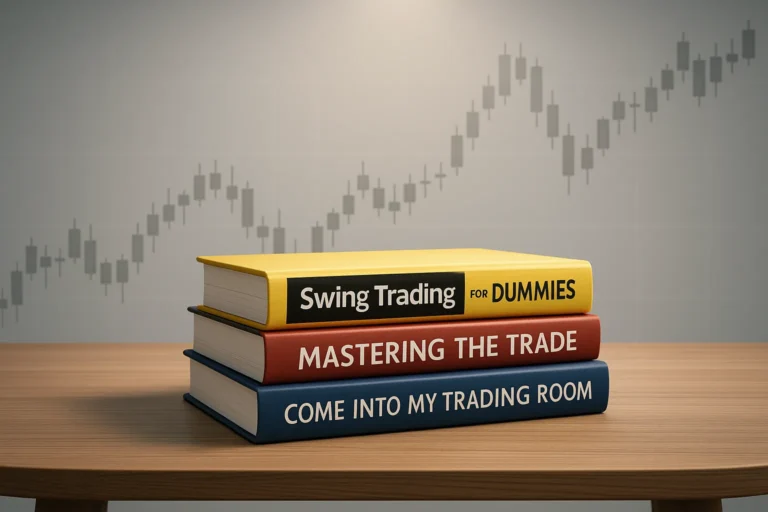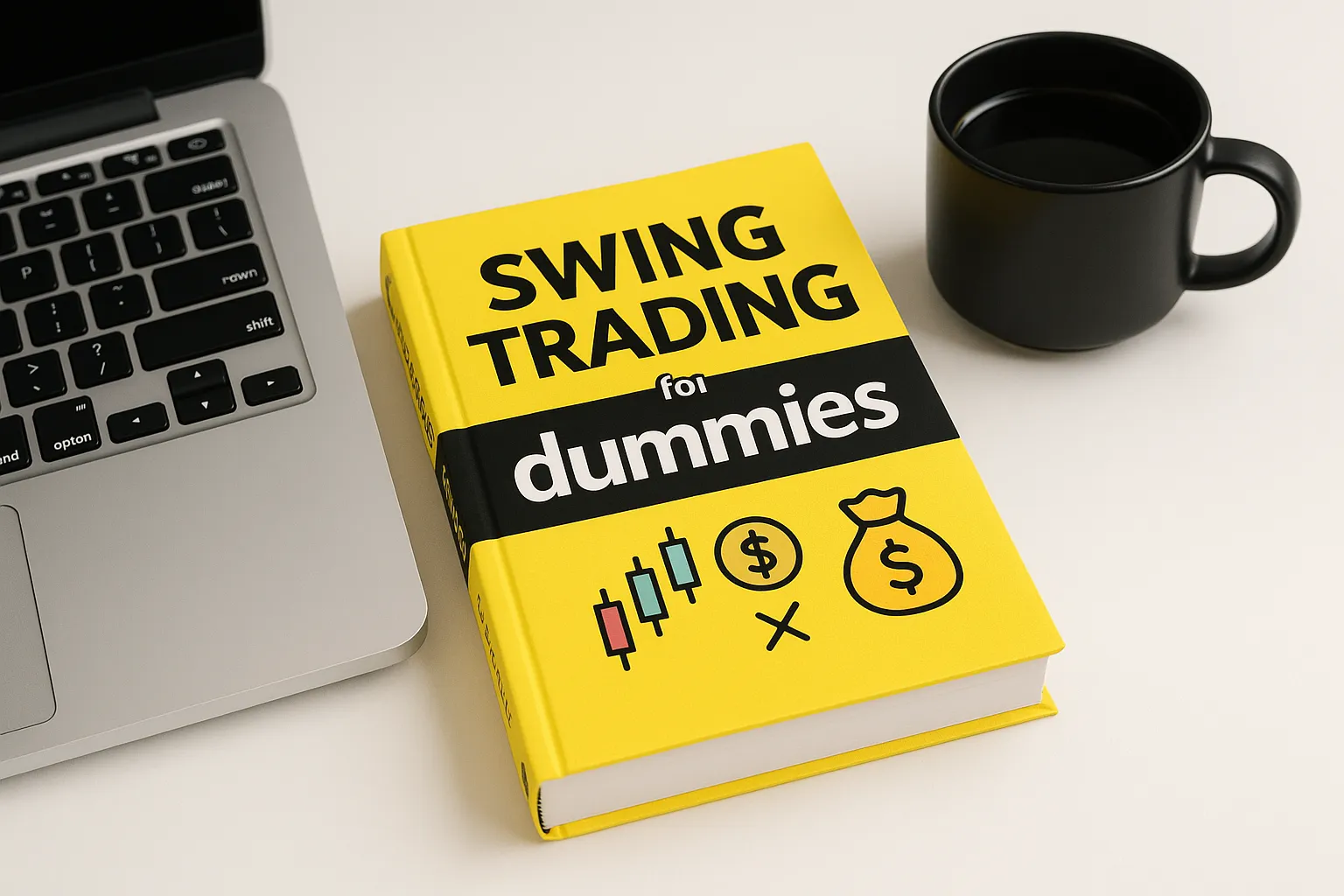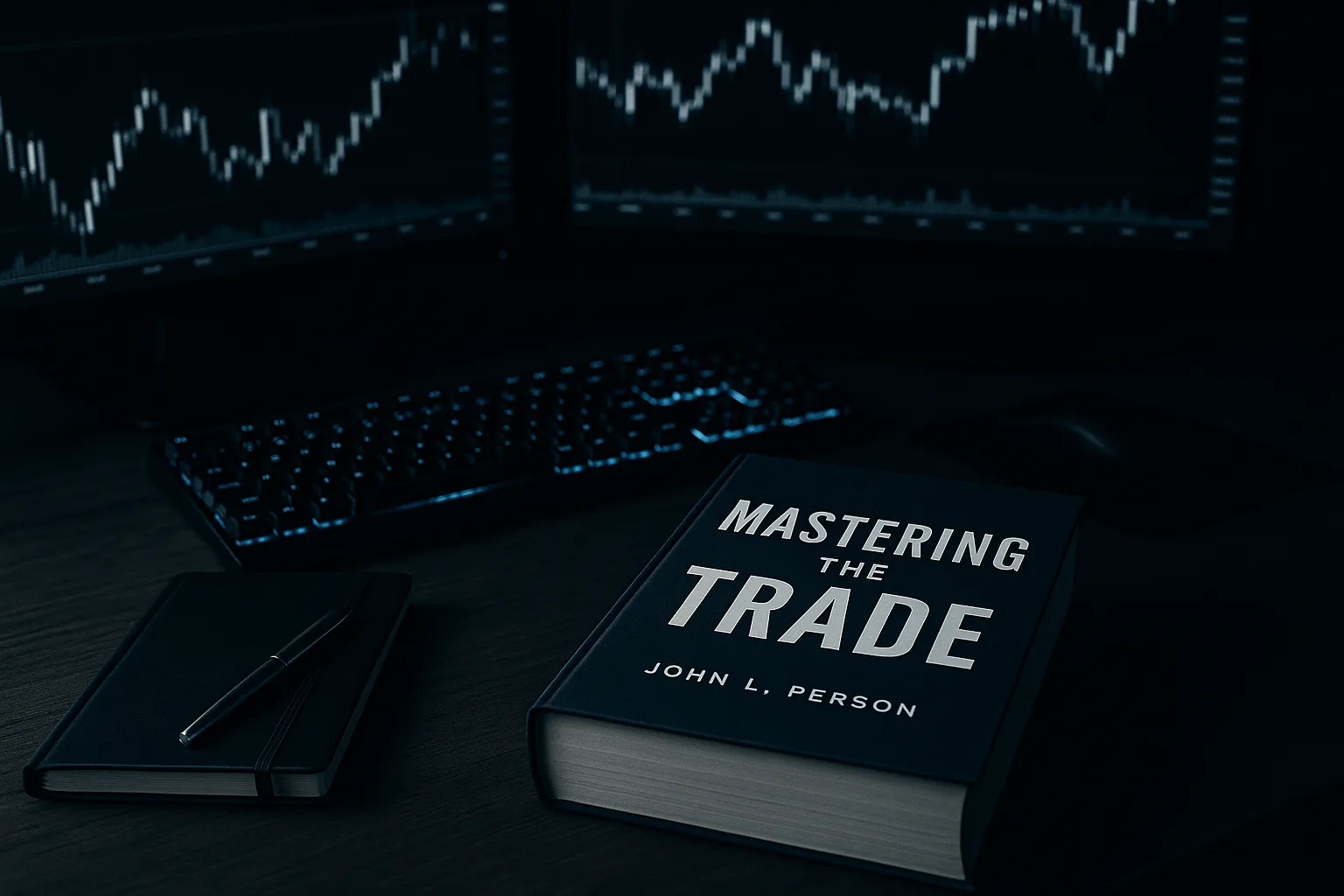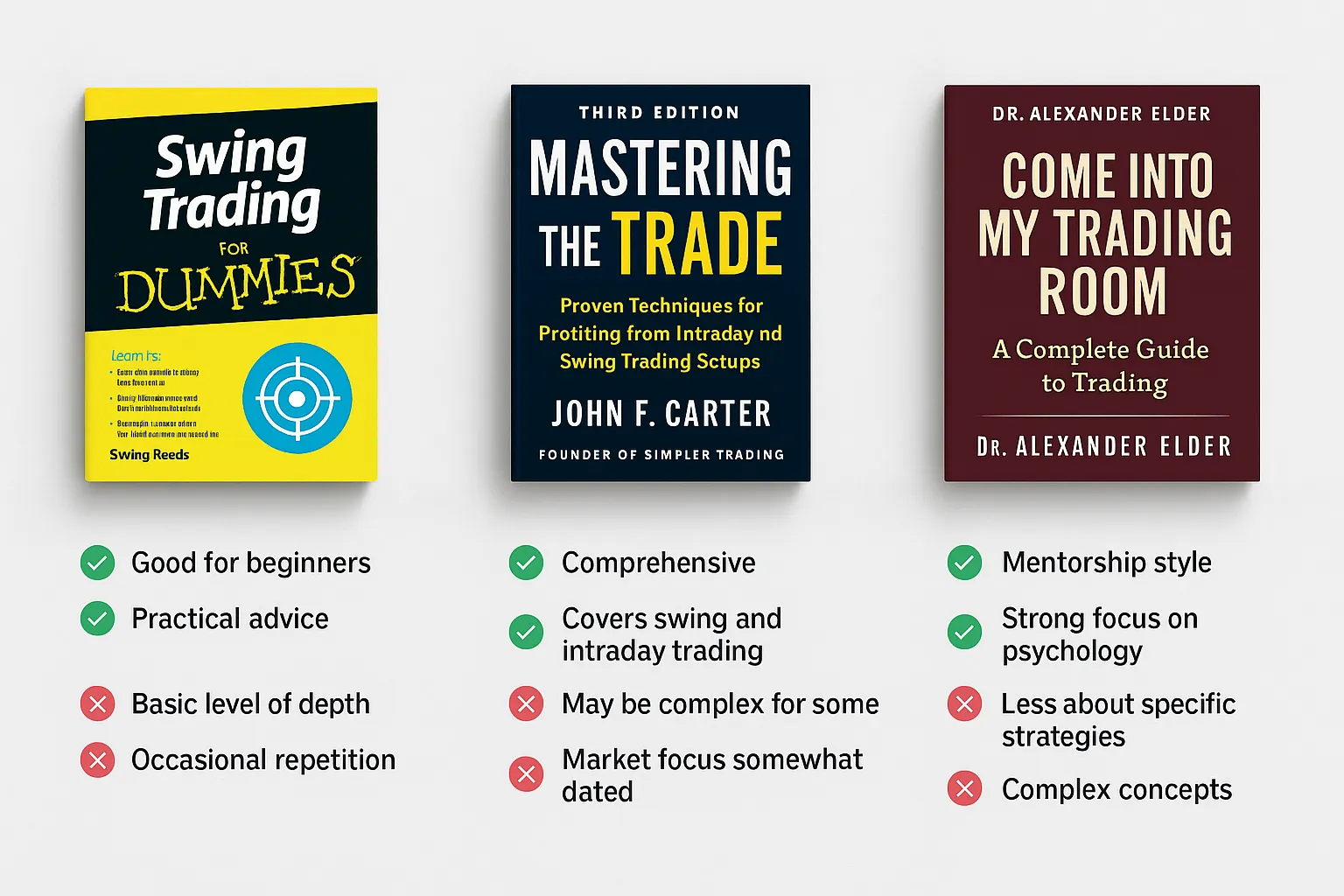
Best Swing Trading Books – Top Three Books
📘 Quick Summary
- 📚 Discover the top 3 swing trading books for beginners and pros alike.
- 🧠 Learn from real trader case studies and expert interviews.
- ✅ Key takeaways, pros and cons, and related resources included.
📌 Table of Contents
- Introduction
- 1. “Swing Trading for Dummies” by Omar Bassal
- 2. “Mastering the Trade” by John F. Carter
- 3. “Come Into My Trading Room” by Dr. Alexander Elder
- Real-Life Case Studies
- Key Takeaways
- FAQ
- Further Reading
🔥 Introduction
Swing trading stands at the sweet spot between day trading and long-term investing. The right education can be the difference between success and failure. With countless resources out there, we’ve narrowed it down to three essential books that every swing trader—novice or pro—should own.
Quote of the Day: “An investment in knowledge pays the best interest.” – Benjamin Franklin
Whether you trade part-time or full-time, these books will help you sharpen your strategies and boost your results. This list also complements our post on best day trading books:contentReference[oaicite:0]{index=0} for those transitioning between strategies.
📗 1. “Swing Trading for Dummies” by Omar Bassal
Best for Beginners. A plain-language introduction to swing trading, this book helps lay a solid foundation. It teaches chart patterns, risk management, and the psychology behind good trades.
What You’ll Learn:
- ✔️ Setting up your trading plan
- ✔️ Entry and exit strategies for swing trades
- ✔️ Basic technical indicators
Pros:
- ✔️ Simple, beginner-friendly language
- ✔️ Covers risk management techniques well
Cons:
- ❌ Lacks advanced technical analysis
- ❌ Less applicable to volatile markets
“Bassal’s clarity is unmatched. This is where I always start new swing traders.” — Emily Tran, Swing Trade Mentor
If you’re interested in combining this book with indicators, you’ll love our resource on the best indicators for swing trading:contentReference[oaicite:1]{index=1}.
For deeper learning, check this external guide from Investopedia.

📘 2. “Mastering the Trade” by John F. Carter
A must-read for intermediate traders looking to take their strategies to the next level. John F. Carter delivers detailed systems for trade setups, entry points, and risk-reward calculations backed by decades of experience.
What You’ll Learn:
- ✔️ Momentum swing setups
- ✔️ Trade management with discipline
- ✔️ Real trader psychology tips
Pros:
- ✔️ Includes working strategies with indicators
- ✔️ Based on real-world trading experience
Cons:
- ❌ Some systems are complex for beginners
- ❌ Assumes prior knowledge of options and futures
“Carter doesn’t just teach trading—he teaches how to think like a trader.” — Brian Hsu, Fund Manager at Elevate Capital
Before diving in, you may want to understand popular swing trading setups:contentReference[oaicite:0]{index=0} that this book expands upon.
For even more perspective, this breakdown by Moneycontrol includes Carter’s work as a top recommendation.

📕 3. “Come Into My Trading Room” by Dr. Alexander Elder
A holistic guide to becoming a consistently profitable trader. Elder covers everything from technical analysis and risk management to time management and psychology. This book is great for traders who want a full 360° view.
What You’ll Learn:
- ✔️ Self-discipline and emotional control
- ✔️ How to build a trading diary
- ✔️ Systems for planning and review
Pros:
- ✔️ Great for self-reflection and mental toughness
- ✔️ Combines psychology and analytics
Cons:
- ❌ Heavy focus on psychology might bore strategy-focused readers
- ❌ Dated in terms of charting platforms
“No book made me rethink my trading discipline like Elder’s. I still use his checklists to this day.” — Janice Rao, Private Trader & Author
We explored many of Elder’s ideas in our guide to swing trading success stories:contentReference[oaicite:1]{index=1}.
To expand further on the psychological side, check out this profile on Elder from Trading Setups Review.

📈 Real-Life Case Studies
Let’s look at how these books shaped real traders’ journeys.
Case Study: Marcus Li, Former Engineer Turned Trader
After losing 30% of his savings through random trades, Marcus read “Swing Trading for Dummies”. He learned how to apply moving averages and RSI to better time his trades. Within six months, he turned his $5,000 account into $9,300 using setups outlined in the book and methods from our swing trading methods guide:contentReference[oaicite:0]{index=0}.
Case Study: Anita Voss, Day Trader Turned Swing Trader
Burned out by daily volatility, Anita switched to swing trading and adopted Carter’s strategies from “Mastering the Trade”. She also joined our swing trading chat room:contentReference[oaicite:1]{index=1} for live discussions. Her consistency improved, and she now makes 3–5 successful trades per month.
🧠 Key Takeaways
- “Swing Trading for Dummies” is ideal for those just starting out.
- “Mastering the Trade” provides advanced tactics with detailed setups.
- “Come Into My Trading Room” emphasizes trader psychology and routine.
- Pairing these books with live tools like Swing Trade Bot:contentReference[oaicite:2]{index=2} enhances learning.
❓ Frequently Asked Questions
Q: Should I read these books in a specific order?
A: Yes. Start with “Swing Trading for Dummies,” then move to Elder or Carter depending on your focus—psychology or systems.
Q: Are these books still relevant in 2025?
A: Absolutely. Core trading principles haven’t changed, and the psychological lessons are timeless.
Q: What tools do I need to apply the lessons?
A: A trading journal, charting software (like TradingView), and a reliable alert service like Day Trading Alerts:contentReference[oaicite:3]{index=3} are highly recommended.
📚 Further Reading
- Best Day Trading Books:contentReference[oaicite:4]{index=4}
- Day Trading vs Swing Trading:contentReference[oaicite:5]{index=5}
- How to Build Discipline and Avoid Overtrading:contentReference[oaicite:6]{index=6}
- Amazon Best Sellers in Trading
- TraderLion’s Top Trading Books

📚 Recommended Resources for Swing Traders
To grow as a swing trader, it’s essential to learn from top-performing investors, regulated platforms, and well-respected analysts. Below are hand-picked, high-authority external resources to support your swing trading journey.
📖 Investopedia – Best Swing Trading Strategies
A well-rounded guide that covers common swing setups, technical tools, and risk management tips.
Read on Investopedia →📊 TradingView – Swing Trade Chart Tools
Use their interactive platform for technical analysis, pattern recognition, and community insights.
Explore TradingView →🧠 Warrior Trading – Swing vs Day Trading
A deep comparison of swing trading and day trading, including tools, timelines, and trader psychology.
Read on Warrior Trading →📘 Benzinga – Best Books for Traders
A recommended list of trading books—many of which overlap with our top swing trading picks.
Visit Benzinga →🔍 FINRA – Trader Education Center
From regulations to fraud prevention, FINRA provides important guidelines for responsible trading.
Learn from FINRA →💡 Tip: Save or Share This List
Resources like these can improve your win rate and discipline. Bookmark this post, and share it with your trading community.
❓ Additional FAQs
- Q: Should I study technical or fundamental analysis for swing trading?
- A: Technical analysis is more commonly used in swing trading for short- to mid-term timing, though some traders blend both.
- Q: Can I apply lessons from these books to penny stocks?
- A: Yes, many of the strategies taught in swing trading books can be applied to penny stocks, especially those with high volume and volatility.
- Q: Is swing trading suitable for beginners?
- A: With proper education, yes. Many traders prefer swing trading over day trading because of its flexible time commitment.